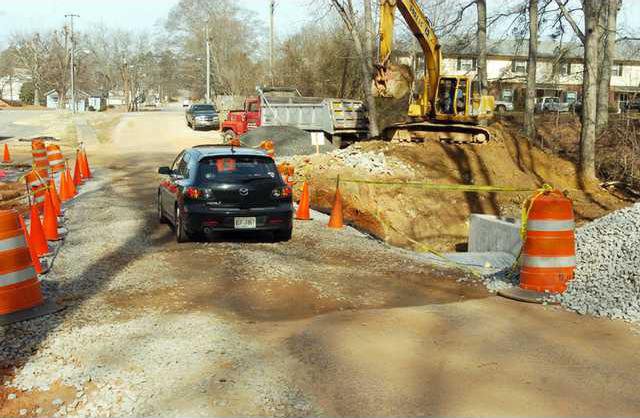0303CULVERTaud
Listen as Flowery Branch city officials discuss needed culvert work at their retreat Saturday.A Flowery Branch engineer has identified two culverts that need to be replaced eventually, including one that could cut off a neighborhood if it fails.
The culvert on Mulberry Street at Phil Niekro Boulevard “may be the one we consider (replacing) next,” said City Planner James Riker.
Unlike a culvert on East Main Street, residents have only one way in or out of the neighborhood.
City officials are mulling future work as they near completion on replacing a culvert on Spring Street, a couple of blocks off Atlanta Highway.
The culvert collapsed Dec. 9 after a night of steady rainfall, stranding residents of the 50-unit Quad Oaks apartments.
Work could be finished later this month, City Manager Bill Andrew said.
“With the way the weather has been, we’re behind schedule,” he said.
The city is spending nearly $150,000 on the project, including about $100,000 left over in the city’s previous special purpose local option sales tax fund and $30,000 in road money set aside in the 2009-10 budget.
At a retreat held Saturday at City Hall, city officials discussed future projects related to culverts built across Mulberry Creek, which cuts through town.
The Mulberry Street culvert is slightly larger than the one at Spring Street, with replacement costs potentially running higher, Riker said.
“It’s something to consider in long term,” he added.
The city also might consider eventually replacing the culvert on Cantrell Road.
“So, there are three (questionable culverts) and of those, two are more important,” Riker said.
The culvert work is something to consider in the next five to 10 years, Andrew said.
“This one that we’re repairing now washed out 15 years ago,” Riker said.
The city and Hall County worked together to replace the pipe and “called it a day.”
“They didn’t do any studies, didn’t analyze of the watershed area that would go to that, and as result, (the culvert) was completely undersized,” Riker said. “What we have now is capable of handling the 100-year (flood under) built-out conditions.”
The reason for those high standards was because of the neighborhood’s restricted access.



